Question
Which one of the following is an example of hormone releasing IUD? [NEET 2021]
(a) Cu-T
(b) LNG-20
(c) Cu-7
(d) Multiload-375
Answer/Explanation
Ans. (b)
Levonorgestrel hormone is released from LNG-20. It is highly effective for contraception. The risk of unwanted pregnancy is lower with LNG-20 because it causes endometrial atrophy and alter
the stroma to inhibit the process of implantation. Lippes loop is an IUD impregnated with barium sulphate. IUDs like CuT and multiload-375 release copper that suppress the motility of sperm thus reducing its fertilising capacity. Thus, Lippes loop, CuT and multiload-375 are not hormone releasing IUDs.
Question
Match the List-I with List-II.
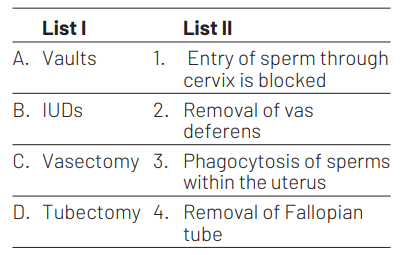
Choose the correct answer from the options given below. [NEET 2021]
A B C D
(a) 4 2 1 3
(b) 1 3 2 4
(c) 2 4 3 1
(d) 3 1 4 2
Answer/Explanation
Ans. (b)
(A)-(1),(B)-(3),(C)-(2),(D)-(4)
Vaults is a rubber dome, which fits over the vaginal vault or cervix. They prevents the entry of sperm into the uterus.
IUDs are the devices which are inserted by the doctors or trained nurses into the uterus of female. These IUDs increase phagocytosis of sperm in uterus.
Vasectomy Surgical removal of the small part of vas deferens. It is a form of male birth control that inhibits to transport of male gamete.
Tubectomy Surgical removal of the small part of Fallopian tube to prevent the sperm from reaching the egg to fertilise it.
Question
Progestogens alone or in combination with oestrogens can be used as a contraceptive in the form of [NEET (Oct.) 2020]
(a) implants only
(b) injections only
(c) pills, injections and implants
(d) pills only
Answer/Explanation
Ans. (c)
Progesteronse alone or in combination with oestrogens can be used as a contraceptive in the form of pills, injections and implants under the skin. They inhibit ovulation and implantation of the zygote as well as alter the quality of cervical mucus to prevent/retard entry of sperms.
Question
Which of the following is a correct statement? [NEET (Odisha) 2019]
(a) IUDs once inserted need not be replaced
(b) IUDs are generally inserted by the user herself
(c) IUDs increase phagocytosis of sperms in the uterus
(d) IUDs suppress gametogenesis
Answer/Explanation
Ans. (c)
Option (c) is correct as Intrauterine Devices (IUDs) increase phagocytosis of sperms within the uterus and the Cu ions released suppress sperm motility and fertilising capacity of sperms.
Other statements can be corrected as IUDs can be removed as these are a reversible contraception method. IUDs are inserted by doctors or expert nurses in the uterus through vagina. IUDs do not affect gametogenesis.
Question
Select the hormone- releasing Intra-Uterine Devices. [NEET (National) 2019]
(a) Multiload 375, Progestasert
(b) Progestasert, LNG-20
(c) Lippes Loop, Multiload 375
(d) Vaults, LNG-20
Answer/Explanation
Ans. (b)
Progestasert and LNG-20 are hormone releasing Intrauterine Devices (IUDs). These devices release small quantities of hormone which suppresses endometrial changes, cause an ovulation and insufficient luteal activity.
Question
Which of the following contraceptive methods do involve a role of hormone? [NEET (National) 2019]
(a) Barrier method, Lactational amenorrhea, Pills
(b) Cu-T, Pills, Emergency contraceptives
(c) Pills, Emergency contraceptives, Barrier methods
(d) Lactational amenorrhea, Pills, Emergency contraceptives
Answer/Explanation
Ans. (d)
Lactational amenorrhea, pills and emergency contraceptives provide contraception due to the role of hormones. In lactational amenorrhoea, high prolactin level during active lactation period decreases the gonadotropin level in the blood.
Pills usually contain progesterone or progesterogen- oestrogen combinations which prevent ovulation. Emergency contraceptives also contain progesterone and estradiol preparation. Other contraceptive methods include Intrauterine Devices (IUDs) which release copper and destroys the sperms. On the other hand, barrier method represents a physical method of contraception. Also, copper-T $(\mathrm{Cu}-\mathrm{T})$ acts by releasing copper and not any hormone.
Question
The function of copperions in copper releasing IUD’s is [NEET 2017]
(a) they suppress sperm motility and fertilising capacity of sperms
(b) they inhibit gametogenesis
(c) they make uterus unsuitable for implantation
(d) they inhibit ovulation
Answer/Explanation
Ans. (a)
An intra uterine device is a small, often T-shaped birth control device that is inserted into a woman’s uterus to prevent pregnancy. The copper releasing IUD’s primarily work by disrupting sperm motility and damaging sperm. Copper acts as a spermicide. It can also alter the endometrial lining, preventing implantation.
Question
Which of the following approaches does not give the defined action of contraceptive? [NEET 2016, Phase I]
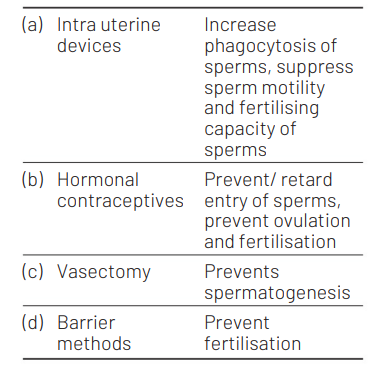
Answer/Explanation
Ans. (c)
In vasectomy, a small part of the vas deferens is removed or tied up through a small incision on the scrotum in males. Vasectomy blocks the gamete transport and does not affect spermatogenesis.
Question
In context of amniocentesis, which of the following statement is incorrect? [NEET 2016, Phase I]
(a) It is used for prenatal sex-determination
(b) It can be used for detection of down syndrome
(c) It can be used for detection of cleft palate
(d) It is usually done when a woman is between 14-16 weeks pregnant
Answer/Explanation
Ans. (c)
Cleft palate is a developmental abnormality which may occur in the developing foetus and so it can be detected by sonography, not by amniocentesis.
Amniocentesis is being misused for foetal sex-determination test so it is banned in India.
Question
Which of the following is incorrect regarding vasectomy? [NEET 2016, Phase II]
(a) No sperm occurs in seminal fluid
(b) No sperm occurs in epididymis
(c) Vasa deferentia is cut and tied
(d) Irreversible sterility
Answer/Explanation
Ans. (b)
Epididymis is an accessory duct present in the male reproductive system.
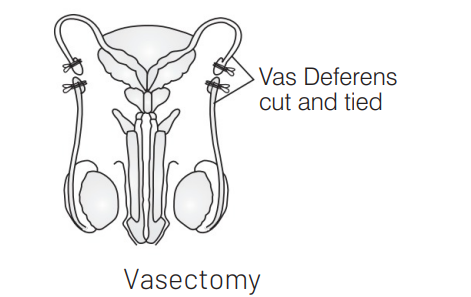
Sperms produced by testes are sent here by vasa efferentia and are temporarily stored here. These sperms do not reach to seminal vesicle when vas deferens is cut and tied in vasectomy.
Question
Which of the following is hormone-releasing IUD? [NEET 2016, Phase II]
(a) LNG-20
(b) Multiload-375
(c) Lippes loop
(d) $\mathrm{Cu}-7$
Answer/Explanation
Ans. (a)
Hormone releasing IUD (Intra Uterine Devices) is LNG-20. The IUD’s are ideal contraceptive methods used by females to prevent pregnancy. The hormone releasing IUD’s make the uterus unsuitable for implantation and the cervix hostile to the sperms. Hence, option (a) is correct. Concept Enhancer Lippes loop is a non-medicated IUD whereas $\mathrm{Cu}-7$ and Multiload-375 are copper releasing IUDs.
Question
Tubectomy is a method of sterilisation in which [CBSE AIPMT 2014]
(a) small part of the Fallopian tube is removed or tied up
(b) ovaries are removed surgically
(c) small part of vas deferens is removed or tied up
(d) uterus is removed surgically
Answer/Explanation
Ans. (a)
Tubectomy is a type of sterilisation. During this procedure female’s, Fallopian tubes are cut and tied up to block entry of sperms into the ovary. In females, this is permanent birth control.
Question
Which of the following cannot be detected in a developing foetus by amniocentesis? [NEET 2013]
(a) Klinefelter’s syndrome
(b) Sex of the foetus
(c) Down’s syndrome
(d) Jaundice
Answer/Explanation
Ans. (d)
Amniocentesis is a foetal sex determination test based on the chromosomal pattern in the amniotic fluid surrounding the developing embryo. Jaundice is a condition not based on chromosomal pattern. It is a disease related to liver dysfunctions.
Question
One of the legal methods of birth control is [NEET 2013]
(a) abortion by taking an appropriate medicine
(b) by abstaining from coitus from day 10-17 of the menstrual cycle
(c) by having coitus at the time of day break
(d) by a premature ejaculation during coitus
Answer/Explanation
Ans. (b)
One of the legal method of birth control is periodic abstinence in which couples abstain from coitus from day 10 to 17 of the menstrual cycle. Abortion by taking medicine is not a legal method. A day
break coitus may increase the chances of contraception.
Question
Which of the following is a hormone releasing Intrauterine Device (IUD)? [CBSE AIPMT 2014]
(a) Multiload 375
(b) LNG-20
(c) Cervical cap
(d) Vault
Answer/Explanation
Ans. (b)
LNG-20 is a hormone releasing IUD, that makes the uterus unsuitable for implantation and cervix hostile to sperm. Intra uterine devices are plastic or metal objects which are inserted by the doctors into the uterus through vagina. These are available as:
Non-medicated IUDs (i.e. lippes loop)
Copper relasing IUDs (e.g. multiload 375)
Hormone releasing (e.g. progestasert).
Cervical caps and vaults are made up of rubber and are inserted into the female reproductive tract to cover the cervix before coitus. They prevent conception.
Question
What is the figure given below showing in particular? [CBSE AIPMT 2012]
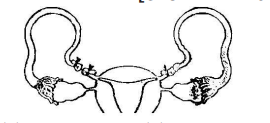
(a) Ovarian cancer
(b) Uterine cancer
(c) Tubectomy
(d) Vasectomy
Answer/Explanation
Ans. (c)
The figure depicts tubectomy The process of cutting and ligating both the oviducts or Fallopian tubes of female is called tubectomy. It is very reliable method of birth control, the approximate failure rate of which is less than $1 \%$.
Question
Which one the following is the most widely accepted method of contraception in India, at present? [CBSE AIPMT 2011]
(a) Cervical caps
(b) Tubectomy
(c) Diaphragms
(d) IUDs (Intra Uterine Devices)
Answer/Explanation
Ans. (d)
At present, the most widely accepted method of contraception in India is IUDs (Intra Uterine Devices). These devices are effective and popular. These devices are inserted by doctors and expert nurses in the uterus through vagina.
Question
The permissible use of the technique amniocentesis is for [CBSE AIPMT 2010]
(a) detecting sex of the unborn foetus
(b) artificial insemination
(c) transfer of embryo into the uterus of a surrogate mother
(d) detecting any genetic abnormality
Answer/Explanation
Ans. (d)
Amniocentesis is a technique for the diagnosis of congenital abnormalities before birth. By karyotypic studies of somatic cells, abnormalities due to the changes in chromosome number like Down’s syndrome, Turner’s syndrome, Klinefelter’s syndrome, etc, can be determined. It can be used as a pre-natal diagnostic technique. These days, amniocentesis is being misused also. Mothers even get their normal foetus aborted if it is a female.
Question
Cu ions released from copper-releasing Intra Uterine Devices (IUDs) [CBSE AIPMT 2010, 2000]
(a) make uterus unsuitable for implantation
(b) increase phagocytosis of sperms
(c) suppress sperm motility
(d) prevent ovulation
Answer/Explanation
Ans. (c)
Intra Uterine Device (IUD) is a small device made up of copper, plastic or stainless steel. It is inserted by a doctor and experts nurses into the uterus through vagina and can be left these for long periods. This device needs to be replaced after 3-5 yrs when Cu release become scanty due to calcium deposition. It supress the sperm mobility and fertilising capacity of sperms.
Question
Consider the statement given below regarding contraception and answer as directed thereafter [CBSE AIPMT 2008]
1. Medical Termination of Pregnancy (MTP) during first trimester is generally safe.
2. Generally chances of conception are nil until mother breast-feeds the infant up to two years.
3. Intra uterine devices like copper-T are effective contraceptives.
4. Contraception pills may be taken upto one week after coitus to prevent contraception.
Which two of the above statements are correct?
(a) 1,3
(b) 1,2
(c) 2,3
(d) 3,4
Answer/Explanation
Ans. (a)
Option I and III are correct as. Intra uterine devices like copper-T are effective contraceptives for birth control. It suppresses sperm motility and the fertilising capacity of the sperm. Medical termination of pregnancy or induced abortion is voluntary or intentional termination of pregnancy before full term of foetus. It is comparatively safe up to 12 weeks (the first trimester) of pregnancy.
Question
Given below are four methods $(A-D)$ and their modes of action (i-iv) in achieving contraception. Select their correct matching from the four option that follow. [CBSE AIPMT 2008]
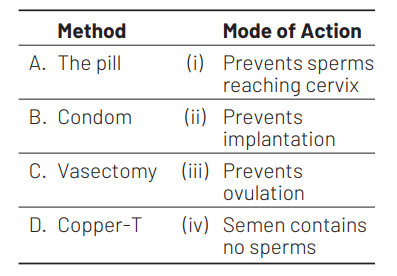
A B C D
(a) (iii) (iv) (i) (ii)
(b) (ii) (iii) (i) (iv)
(c) (iii) (i) (iv) (ii)
(d) (iv) (i) (ii) (iii)
Answer/Explanation
Ans. (c)
The contraceptive pills are hormones either in combination or progesterone only that primarily prevent release of egg. It is convenient and highly effective, significant non-contraceptive health benefits such as protection against ovarian and endometrial cancers.
Condom is thin rubber sheath for penis that collects semen. It is easy to use, effective and inexpensive.
Vasectomy is the cutting and tying off the ductus deference so, that sperm connot enter the ejaculate.
Copper- $T$ is small plastic device placed in the uterus that prevent fertilisation or implantation.
Question
In a population, unrestricted reproductive capacity is called [CBSE AIPMT 2002]
(a) biotic potential
(b) fertility
(c) carrying capacity
(d) birth rate
Answer/Explanation
Ans. (a)
The biotic potential or innate capacity to increase of a population refers to the maximum rate of increase in the population that can possibly occur under ideal conditions (unlimited resources, no hindrances).
Question
Progesterone, which is the most important component of oral contraceptive pils, prevents pregnancy by [CBSE AIPMT 2000]
(a) preventing the formation of egg
(b) preventing the cleavage of the fertilised egg
(c) creating unfavourable chemical environment for the sperms to survive in the famale reproductive tract
(d) blocking ovulation
Answer/Explanation
Ans. (d)
Most contraceptive pills contain the hormones oestrogen and progesterone. Progesterone, alongwith oestrogen, disturbs the normal menstrual cycle to prevent ovulation. It inhibits the pituitary from secreting FSH and LH, which leads to blocking of ovulation.
Question
Tablets to prevent contraception contain [CBSE AIPMT 1999]
(a) progesterone
(b) $\mathrm{FSH}$
(c) $\mathrm{LH}$
(d) Both (b) and (c)
Answer/Explanation
Ans. (a)
Contraceptive pills for women contain female sex hormones oestrogen and progesterone. These prevent development of eggs and ovulation by inhibiting secretion of FSH. Some pills contain progesterone only in such cases, ovulation may occur but cervical mucus is thickness preventing the entry of sperm.
Question
Amniocentesis is a process to [CBSE AIPMT 1997]
(a) determine any disease in heart
(b) determine any hereditary disease in the embryo
(c) know about the disease of brain
(d) All of the above
Answer/Explanation
Ans. (b)
Cells of amniotic fluid are cultured to increase their number and to obtain dividing cells. The chromosomes of the dividing cells can be examined for abnormalities. The cells and the fluid sample may also be tested for products of faulty genes (e.g. high level of $\alpha$-fetiprotein, i.e. AFP) indicated high risk of birth defects.
Question
Human population growth in India [CBSE AIPMT 1996]
(a) tends to follow a sigmoid curve as in case of many other animal species
(b) tends to reach zero population growth as in case of some animal species
(c) can be reduced by permitting natural calamities and enforcing birth control measures
(d) can be regulated by following the National programme of family planning
Answer/Explanation
Ans. (d)
Though India is very crowded and over populated country but still human population can be regulated by following the National programme of family planning.
Question
In India, human population is heavily weighed towards the younger age groups as a result of [CBSE AIPMT 1995]
(a) short life span of many individuals and low birth rate
(b) long life span of many individuals and low birth rate
(c) short life span of many individuals and high birth rate
(d) long life span of many individuals and high birth rate
Answer/Explanation
Ans. (c)
In India human population is heavily weighed towards the younger age group as a result of high birth rate and short life span of individuals.
